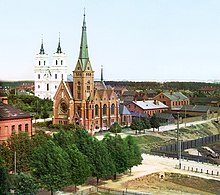| Revision as of 06:22, 7 January 2006 edit69.246.97.12 (talk) →Notable People← Previous edit | Revision as of 15:22, 8 January 2006 edit undoPeteris Cedrins (talk | contribs)Extended confirmed users914 edits Rothko was an Abstract Expressionist; removed Igor Shleypak (if he is really famous, there should be some info on him...).Next edit → | ||
| Line 15: | Line 15: | ||
| The city is surrounded by beautiful lakes. All this makes the city a promising region for the development of international tourism. | The city is surrounded by beautiful lakes. All this makes the city a promising region for the development of international tourism. | ||
| One of the most famous persons born in Daugavpils is ] painter ]. In the early ], it simultaneously housed two prominent ]s: ] and ] (the ''Rogachover Gaon''). | One of the most famous persons born in Daugavpils is ] painter ]. In the early ], it simultaneously housed two prominent ]s: ] and ] (the ''Rogachover Gaon''). | ||
| == Notable People == | == Notable People == | ||
| Line 21: | Line 21: | ||
| *] | *] | ||
| *] | *] | ||
| *] | |||
| *] | *] | ||
| *], the ''Rogachover Gaon'' | *], the ''Rogachover Gaon'' | ||
| Line 35: | Line 34: | ||
| * | * | ||
| * | * | ||
| * | * | ||
| ] | ] | ||
Revision as of 15:22, 8 January 2006
Daugavpils (Belarusian Дзьвінск Dźvinsk, Russian Двинcк Dvinsk, Lithuanian Daugpilis, German Dünaburg, Polish Dźwinów, Dźwińsk or Dyneburg, Yiddish דענענבורג Denenburg), population 115,265 in 2000 census) is the second largest city in Latvia. The first historical reference goes back to 1275. Thus, the year 2000 was celebrated as the 725th anniversary of the city. Between 1561 and 1772, Daugavpils belonged to Poland-Lithuania and was called Dyneburg, capital of Polish-Lithuanian Livonia. Daugavpils got town rights in 1582. Daugavpils was called Borisoglebsk (Russian "Борисоглебск") during 1656-67.
Daugavpils is located approximately 230 km south-east of the capital of Latvia, Riga, on the banks of the Daugava River which is over 1000 km in length and which flows from its source in Russia, through Belarus and Latvia before entering the Baltic Sea via the Gulf of Riga.
The city has a favourable geographical position as it borders with Belarus and Lithuania (distances of 33 and 25 km respectively). It is located some 120 km from the borderline with Russia.

Daugavpils is an important cultural centre in Eastern Latvia. There are 22 primary and secondary schools, 4 vocational schools and "Saules" school. More than 1,000 teachers and engineers graduate from the Daugavpils Pedagogical University and local branch of the Riga Technical University annually.
The city theatre was restored a couple of years ago. Besides, there are also cinemas and other cultural institutions. The city exhibition centre offers a lot of cultural activities.
There are many architectural, historical and cultural monuments in Daugavpils. The most prominent is the Daugavpils Fortress of the eighteenth century.
The city is surrounded by beautiful lakes. All this makes the city a promising region for the development of international tourism.
One of the most famous persons born in Daugavpils is Abstract Expressionist painter Mark Rothko. In the early 20th century, it simultaneously housed two prominent Rabbis: Meir Simcha of Dvinsk and Yosef Rozen (the Rogachover Gaon).
Notable People
- Grzegorz Fitelberg
- Solomon Mikhoels
- Władysław Raginis
- Mark Rothko
- Yosef Rozen, the Rogachover Gaon
- Uljana Semjonova
- Meir Simcha of Dvinsk
See also
- Battle of Daugavpils
- Dinaburg FC - Daugavpils football team